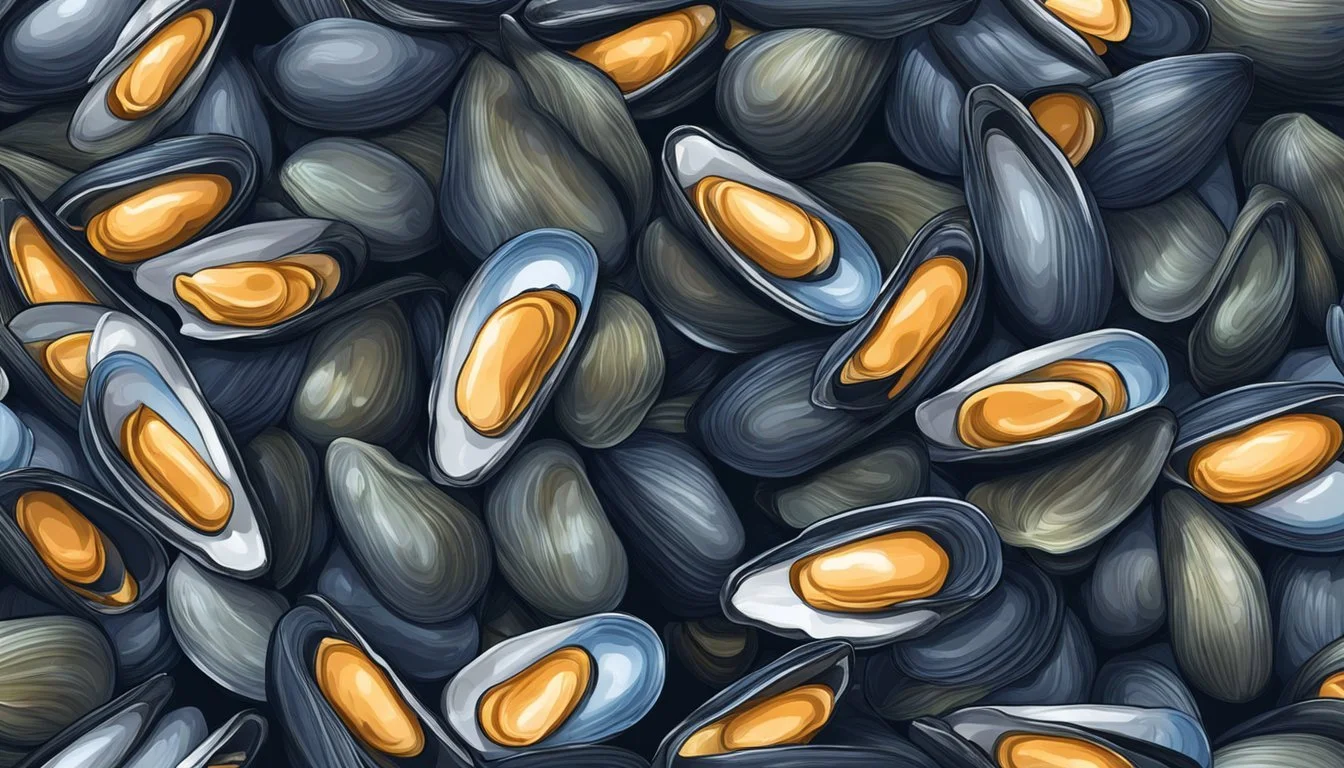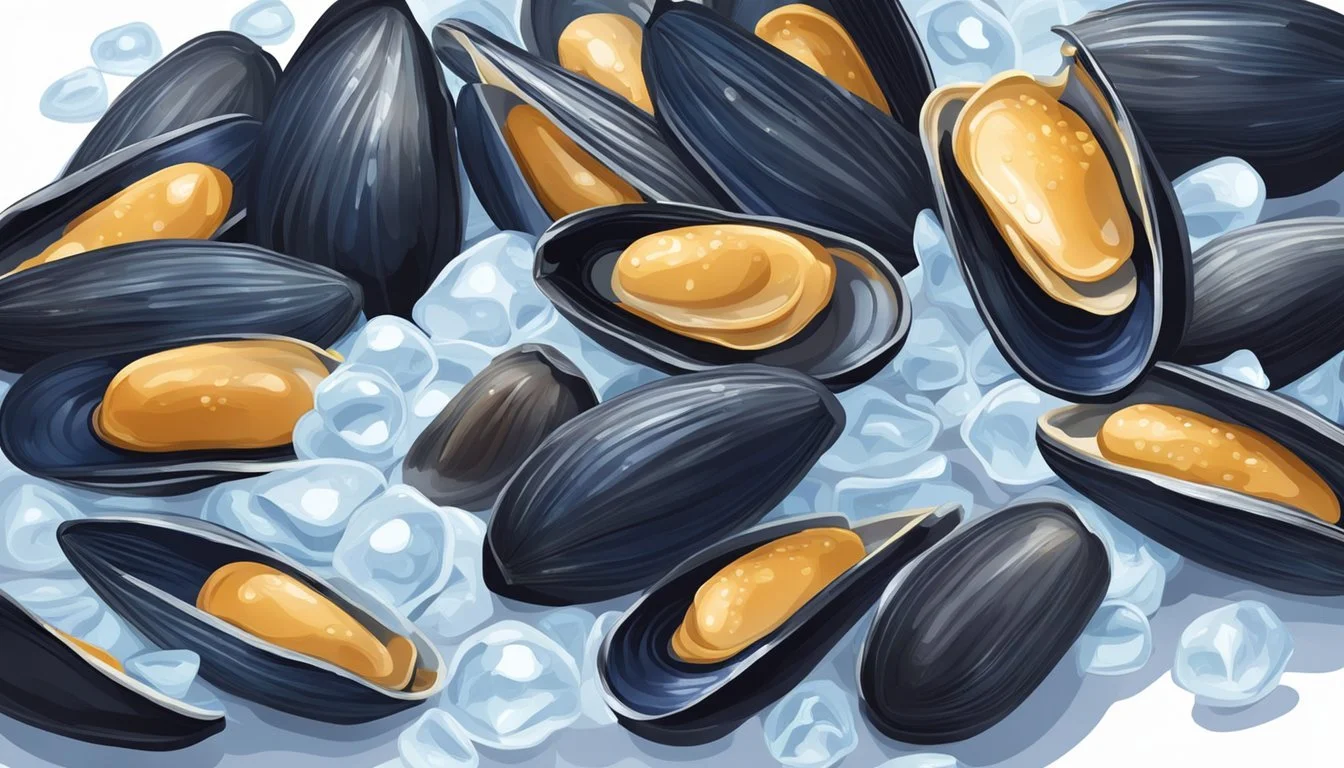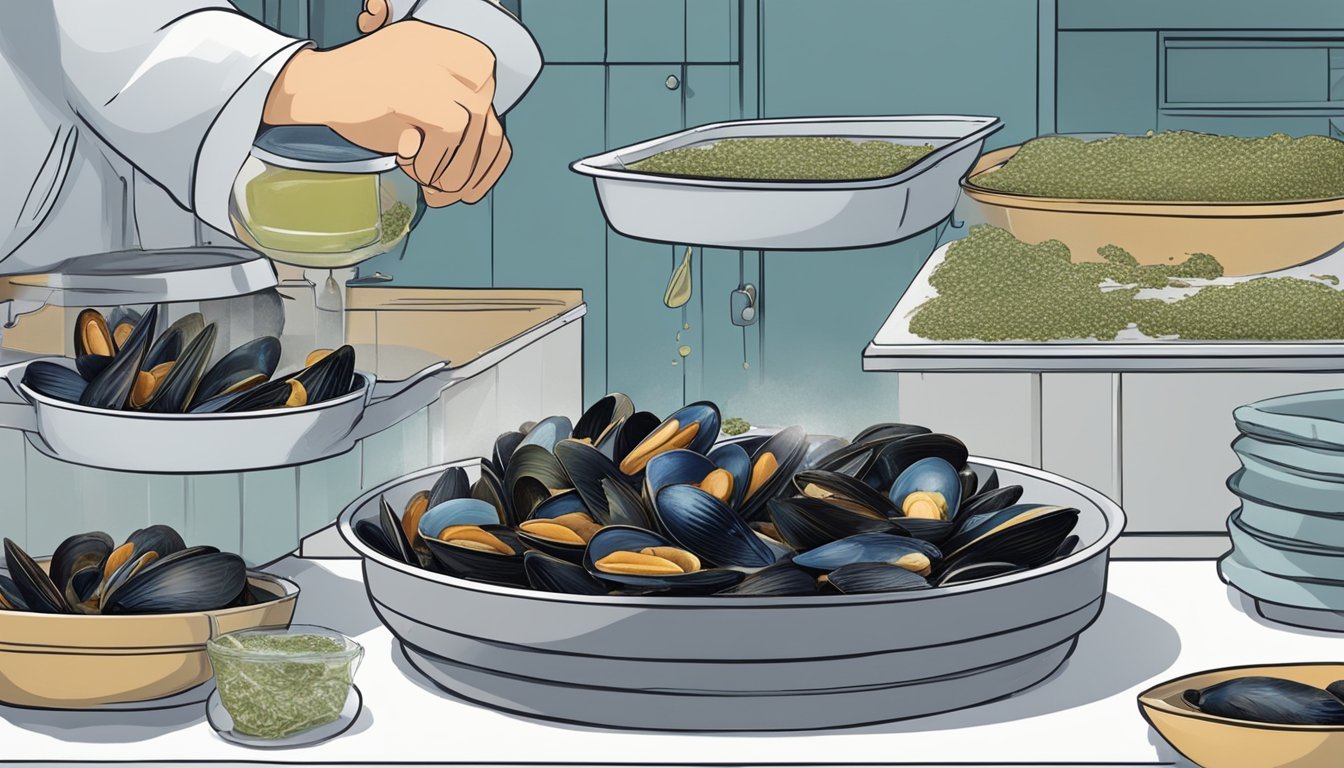Frozen vs Fresh Mussels: A Seafood Comparison
Mussels are a popular seafood delicacy enjoyed by many. When it comes to preparing these briny bivalves, cooks often face a choice between fresh and frozen options. Both frozen and fresh mussels can be excellent choices, but they have distinct characteristics that affect their preparation and taste.
Fresh mussels offer a superior taste and texture when prepared properly. They require careful handling and should be cooked within a day or two of purchase. Frozen mussels, on the other hand, provide convenience and longer shelf life. They are typically pre-cooked and only need reheating, making them a quick and easy option for busy cooks.
The decision between frozen and fresh mussels often depends on factors such as availability, cooking skill, and intended use. Fresh mussels are ideal for dishes where their delicate flavor and tender texture can shine. Frozen mussels work well in soups, stews, and other dishes where they are part of a larger flavor profile.
The Basics of Mussels
Mussels are bivalve mollusks prized for their delicate flavor and tender texture. They offer nutritional benefits while serving as environmental indicators in marine ecosystems.
Freshness and Quality Indicators
Fresh mussels should have tightly closed shells or close when tapped. Open shells that don't respond to touch indicate dead mussels, which should be discarded. The shells should be intact, free of cracks or damage.
Live mussels emit a mild, pleasant sea scent. Avoid any with a strong fishy or ammonia odor, as this suggests spoilage. When cooked, mussels should open easily. Discard any that remain closed after cooking.
Farm-raised mussels often have cleaner shells and more consistent quality than wild-caught varieties. They are typically grown on ropes suspended in water, reducing grit and promoting uniform growth.
Mussel Varieties and Selection
Common mussel varieties include blue mussels, Mediterranean mussels, and green-lipped mussels. Blue mussels are widely available and have a sweet, mild flavor. Mediterranean mussels are larger with a richer taste. Green-lipped mussels from New Zealand offer a distinctive appearance and robust flavor.
When selecting mussels, look for:
Shiny, wet shells
Uniform size for even cooking
Heavy feel, indicating they're full of liquid
Mussels are rich in iron, zinc, and vitamin B12. They absorb flavors well, making them versatile for various cuisines. Fresh mussels are ideal, but properly frozen mussels can be a convenient alternative, maintaining much of their nutritional value and taste.
Nutritional Profile
Mussels offer an impressive array of nutrients while being low in calories and fat. They provide an excellent source of protein, minerals, and vitamins essential for various bodily functions.
Health Benefits of Mussels
Mussels pack a substantial protein punch, delivering around 20 grams per 3-ounce serving. This makes them an ideal choice for muscle maintenance and growth. Despite their high protein content, mussels remain relatively low in calories, with approximately 146 calories per serving.
These mollusks are rich in iron and zinc, supporting red blood cell production and immune function. A standout nutrient in mussels is vitamin B12, crucial for nerve health and DNA synthesis. One serving can provide over 100% of the daily recommended intake of this vital vitamin.
Mussels also contain other B vitamins, including B6, which aids in energy production and cognitive function. Their nutritional density extends to vitamin A, promoting eye health and immune system strength.
For those watching their fat intake, mussels offer a lean protein option. They contain minimal saturated fat while providing beneficial omega-3 fatty acids, supporting heart and brain health.
Storing Mussels
Proper storage techniques are crucial for maintaining the quality and safety of mussels. Temperature control, handling methods, and storage duration all play key roles in preserving these delicate shellfish.
Shelf Life Considerations
Fresh mussels have a limited shelf life and should be consumed quickly. Live mussels can last 3-4 days when properly refrigerated. Discard any mussels with cracked shells or that don't close when tapped.
Cooked mussels keep for 3-4 days in the refrigerator. Frozen mussels maintain quality for up to 3 months. Always check for signs of spoilage before consuming stored mussels.
Date containers clearly to track storage time. Use within recommended timeframes to ensure the best flavor and texture.
Proper Refrigeration Techniques
Store live mussels at 32-35°F (0-1.5°C) in the refrigerator. Place them in a bowl covered with a damp cloth or paper towel. Do not submerge in water or seal in airtight containers.
Clean mussels before refrigerating:
Rinse under cold water
Scrub shells to remove debris
Remove beards by pulling toward the hinge
For cooked mussels, cool quickly and refrigerate in shallow airtight containers within 2 hours of cooking. Keep refrigerator temperature at or below 40°F (4°C) to prevent bacterial growth.
Freezing and Thawing Protocols
Freeze live or cooked mussels for longer storage:
Clean and prepare mussels
Wrap tightly in plastic wrap or freezer paper
Place in heavy-duty freezer bags
Remove excess air
Label with date and contents
Freeze at 0°F (-18°C) or below
To thaw, transfer frozen mussels to the refrigerator for 24 hours. Never thaw at room temperature. Use thawed mussels within 2 days. Cook previously frozen mussels thoroughly before eating.
For best quality, use frozen mussels within 3 months. While safe indefinitely when frozen, quality may decline over time.
Preparation Techniques
Proper preparation is crucial for both frozen and fresh mussels to ensure optimal flavor and safety. Key steps include thorough cleaning and careful opening techniques.
Cleaning and Debearding
Rinse mussels under cold running water to remove sand and debris. Scrub the shells with a stiff brush to eliminate any remaining dirt. Check for cracked or open shells, discarding any that don't close when tapped.
Remove the beard - the fibrous strands protruding from the shell. Grasp the beard firmly and pull it towards the hinge of the mussel. A sharp tug should remove it completely. For stubborn beards, use a small knife to cut as close to the shell as possible.
Frozen mussels often come pre-cleaned, but it's still wise to rinse them after thawing. Pat dry with paper towels before cooking to prevent excess water from diluting the flavors.
Opening Mussels Safely
Most mussels open naturally during cooking. Steam them in a pot with a small amount of liquid for 5-7 minutes until the shells open. Discard any that remain closed after cooking.
For raw preparations, use an oyster knife to pry open live mussels. Hold the mussel firmly with a cloth to protect your hand. Insert the knife between the shells near the hinge and twist to separate them. Cut the muscle attaching the mussel to the shell.
Never force open a tightly closed raw mussel. This indicates it's alive and safe to cook. Conversely, discard any mussels with shells that are open before cooking and don't close when tapped.
Cooking Methods
Mussels can be prepared using various techniques, each imparting unique flavors and textures. Proper cooking methods ensure tender, flavorful results whether using fresh or frozen mussels.
How to Steam Mussels
Steaming is a popular method for cooking mussels. Place mussels in a large pot with a small amount of liquid like white wine, garlic, and herbs. Cover and steam for 5-7 minutes until shells open. Discard any unopened mussels.
For frozen mussels, increase steaming time to 8-10 minutes. Thaw first if possible for more even cooking.
Steam frozen mussels directly from frozen if pressed for time. Add an extra minute or two to the cooking time.
Serve steamed mussels immediately with crusty bread to soak up the flavorful broth.
Baking Techniques for Mussels
Baking mussels creates a delicious crust while keeping the meat tender. Preheat oven to 375°F (190°C). Arrange mussels on a baking sheet in a single layer.
For added flavor, top mussels with breadcrumbs, herbs, and grated cheese before baking. Drizzle with olive oil or melted butter.
Bake for 10-15 minutes until shells open and toppings are golden brown. Frozen mussels may require an extra 2-3 minutes.
Try stuffed mussels by mixing cooked mussel meat with breadcrumbs and herbs, then baking in half shells.
Tips for Sautéing Mussels
Sautéing mussels creates a flavorful dish in minutes. Heat olive oil or butter in a large skillet over medium-high heat. Add garlic and shallots, cooking until fragrant.
Add mussels and white wine. Cover and cook for 3-5 minutes, shaking the pan occasionally. Mussels are done when shells open.
For frozen mussels, thaw first and pat dry to prevent excess liquid. Increase cooking time by 1-2 minutes.
Finish with fresh herbs like parsley or cilantro. Serve immediately with the pan sauce.
Making Mussel Soups and Broths
Mussels make excellent additions to soups and broths. Start by sautéing aromatics like onions, celery, and garlic in a large pot.
Add broth or wine and bring to a simmer. Fresh mussels can be added directly. For frozen, partially thaw first.
Simmer for 5-7 minutes until mussels open. Remove mussels and set aside. Continue cooking the broth, adding cream or tomatoes if desired.
Return mussels to the pot just before serving. Garnish with fresh herbs and serve with crusty bread.
Serving and Pairings
Mussels pair wonderfully with various accompaniments and wines that enhance their delicate flavor. Proper pairings can elevate the dining experience, complementing the briny taste of mussels.
Accompaniments for Enhancing Flavor
Crusty bread is essential for soaking up flavorful mussel broth. French baguettes or sourdough work well. Garlic bread adds extra zest.
Pasta makes an excellent base. Linguine or spaghetti tossed with olive oil, garlic, and lemon zest complements mussels nicely.
For a lighter option, serve mussels over rice. Arborio or basmati rice absorb the broth's flavors.
Lemon wedges brighten the dish. A squeeze of fresh lemon juice adds a tangy note.
Melted butter with minced garlic creates a rich dipping sauce. Mix in chopped parsley for freshness.
Suggested Wine Pairings
White wines pair best with mussels. Crisp, dry whites cut through richness and complement briny flavors.
Sauvignon Blanc offers bright acidity and citrus notes. Its herbaceous qualities match well with garlic and herbs.
Muscadet, a French white, has mineral undertones that echo the sea. Its light body won't overpower the mussels.
Pinot Grigio provides a neutral backdrop. Its subtle flavors allow the mussels to shine.
For richer preparations, try an unoaked Chardonnay. It stands up to cream-based broths without dominating.
Sparkling wines like Prosecco or Cava cleanse the palate between bites. Their bubbles contrast nicely with the soft texture of mussels.
Safety and Quality
Proper handling and assessment of mussels is crucial for food safety and quality. Knowing how to identify bad mussels and prevent foodborne illness ensures a safe and enjoyable dining experience.
Identifying Bad Mussels
Fresh mussels should have tightly closed shells or shells that close when tapped. Discard any mussels with cracked or broken shells. Open mussels that don't close when tapped are likely dead and unsafe to eat.
For frozen mussels, inspect the package for signs of freezer burn or ice crystals. These may indicate quality loss. Once thawed, apply the same criteria as fresh mussels.
Cooked mussels should open wide. Discard any that remain closed after cooking, as they may have been dead before cooking began.
A strong, fishy odor is a red flag for both fresh and frozen mussels. Good mussels have a mild, ocean-like scent.
Preventing Foodborne Illness
Proper storage is key to preventing bacterial growth. Keep fresh mussels refrigerated at 40°F (4°C) or below. Use within 1-2 days of purchase.
Frozen mussels should remain at 0°F (-18°C) or below until ready to use. Thaw in the refrigerator, never at room temperature.
Cook mussels thoroughly to kill potential bacteria. They're done when the shells open wide and the meat is firm and opaque.
Serve hot mussels immediately. For cold dishes, chill quickly and serve on ice if they'll be out for more than 2 hours.
Practice good hygiene. Wash hands, utensils, and surfaces before and after handling mussels to prevent cross-contamination.
After Cooking Care
Proper handling of cooked mussels is essential for food safety and quality. Once mussels are cooked, they should be consumed promptly for the best flavor and texture.
If there are leftovers, store them properly in an airtight container in the refrigerator. Cooked mussels can be kept for up to 3-4 days when refrigerated.
The cooking liquid from mussels can be saved and used as a flavorful base for soups or sauces. Strain it and store in a separate container in the refrigerator.
When reheating leftover mussels, use gentle heat to avoid overcooking. A quick steam or brief warming in a covered pan works well.
For short-term storage, wrap cooked mussels in aluminum foil before refrigerating. This helps retain moisture and prevents them from absorbing other food odors.
Freezing cooked mussels is possible but may affect texture. If freezing, remove them from their shells and store in an airtight container or freezer bag for up to 3 months.
Always discard any mussels that remain closed after cooking, as they may not be safe to eat.
Recipe Ideas
Mussels lend themselves to a variety of delicious preparations, from classic French dishes to creative modern twists. These versatile bivalves pair well with pasta, herbs, and cheese for satisfying meals.
Classic Mussel Dishes
Moules marinière is a quintessential French mussel recipe. Mussels are steamed in white wine with shallots, garlic, and herbs. Serve with crusty bread to soak up the flavorful broth. Another traditional preparation is mussels in tomato sauce, popular in Italian cuisine. The mussels are cooked in a rich tomato sauce with garlic and basil.
For a simple yet elegant dish, try linguine with mussels. Cook pasta while steaming mussels with garlic, white wine, and red pepper flakes. Toss the pasta with the mussels and their cooking liquid. Finish with a sprinkle of parsley and grated Parmesan cheese.
Creative Twists on Traditional Recipes
For a Thai-inspired dish, steam mussels in coconut milk with lemongrass, ginger, and chili. Serve over rice or rice noodles for a comforting seafood meal. Another creative option is mussels with bacon and beer. The smoky flavor of bacon complements the briny mussels, while beer adds depth to the sauce.
Grilled mussels offer a fun twist on the usual steamed preparations. Grill mussels in their shells until they open, then top with herb butter or spicy aioli. For a hearty dinner, try mussels baked with breadcrumbs, garlic, and Parmesan cheese. This dish combines the briny taste of mussels with a crispy, savory topping.





